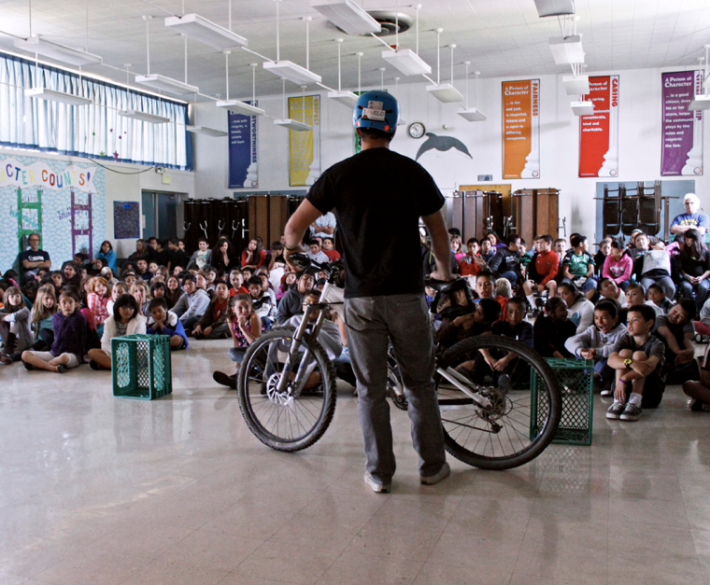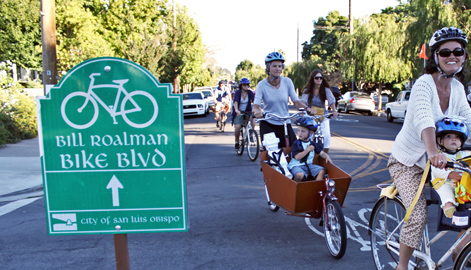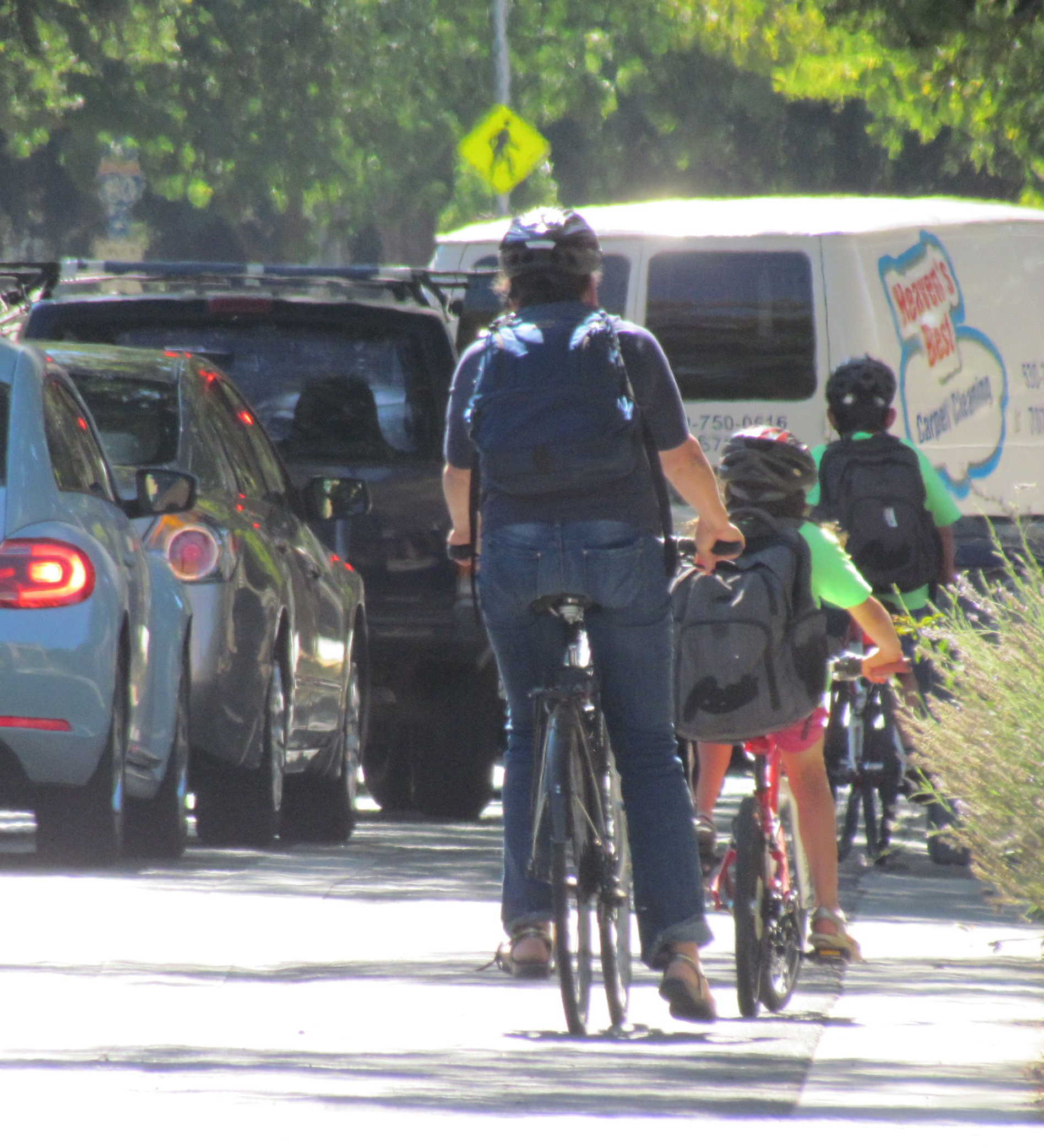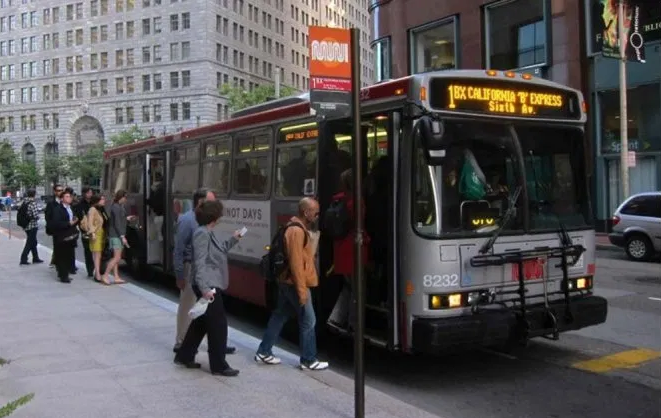Santa Cruz and San Luis Obispo: New Gold-Level Bicycle Friendly Cities
2:47 PM PST on November 20, 2015
Two California cities—Santa Cruz and San Luis Obispo—have been newly designated as “gold-level” bicycle-friendly communities by the League of American Bicyclists. Two other California cities were added to the list as well, both earning a “bronze” level designation: Santa Rosa and Woodland.
California now has 56 bicycle-friendly communities, the most of any state in the U.S. See after the jump for the complete list. California also has the most bicycle-friendly businesses (84) and universities (14) of any state.
The bicycle-friendly designations are earned by communities that apply for it, and range from platinum at the top (there is theoretically a “diamond” designation but even top-rated Davis, California hasn't yet reached that high) to gold, silver, bronze, and honorable mention.
The designation lasts four years, after which a community must reapply. Santa Cruz had previously earned a silver-level designation, and had fallen off the list because the city had not reapplied. So Amelia Conlon, director of Bike Santa Cruz County, put together a group of volunteers to take on the task. Hoping to achieve their previous silver-level status, they were pleased to find that instead the city moved up to gold.
Santa Cruz
Conlon credits a high bike commute mode share (ten percent of workers commute by bike in Santa Cruz) and the city's highly successful, twice-yearly Bike to Work Day events.
“We have a really high rate of bike commuting within Santa Cruz,” she says, “and our education and encouragement programs are very, very strong—comparable to what a platinum-level city would have. There are many groups in the area doing bike safety education, including bike rodeos in schools, bike safety classes at UC Santa Cruz, and learn-to-ride classes. We also have a ticket deferral program,” in which bike riders who receive traffic tickets can reduce their find by taking a safety course through the county health services agency.
Newly completed projects and planned projects with firm funding commitments from the city council help the city's bicycle-friendly status as well. A new multiuse path connection between downtown Santa Cruz, Live Oak, and Capitola will provide an unprecedented car-free way to get across the county by bike. And the city council has committed $1 million to fund a rail-trail project across the west side of Santa Cruz.
The city is also at work on its first active transportation plan, which will update its 2008 bike plan with “cutting edge” bike facilities that will help create a comprehensive bikeways network, according to Conlon. The old bike plan was basically a list of projects, but the update will incorporate pedestrian projects, a public outreach plan, and plans for funding and implementing the projects.
“We're also very proud of the fact that Santa Cruz installed its first green lane treatments this year,” she added. “It signifies a willingness to embrace a new generation of bike facilities in Santa Cruz.”
San Luis Obispo
In San Luis Obispo, the other newly minted gold level bicycle-friendly community, the local bike advocacy group didn't need to work on the application because two Cal Poly professors, Billy Riggs and Michael Boswell, were enthusiastic about taking on the task. Nevertheless, Bike SLO County has helped other communities in the county achieve bicycle-friendly status, according to executive director Dan Rivoire. Nearby Paso Robles, Morro Bay, and Arroyo Grande have all achieved bronze-level status.
Rivoire credits strong grassroots support and a good working relationship between advocates and city staff for San Luis Obispo's gold-level status. He describes the city's approach as “scalpel-like.” By honing in on key intersections and bikeway connections and making small fixes such as removing a stop sign or adding green-backed sharrows, engineers have been able to make big differences. He describes one intersection where a stop sign was reoriented to make a bikeway work better, and it turned out to be an even bigger benefit for people walking. “It was an awkward crossing for people trying to get downtown,” he says. “I would see parents with kids stuck there, not being able to cross, for a long time. Now it's great to see how easy it is to cross there.”

“We are very pleased with the work that's being done by city staff in pushing forward some really great, affordable changes that are improving people's lives,” said Rivoire. “The city's application looks good—in terms of things like miles of green lanes, for example—but also when the League asks for reviews from local advocates, they get very positive responses. Advocates really appreciate the work the city's been doing.”
San Luis Obispo's gold status is also due to strong bike-friendly policies. In January, the city council approved a general plan update that included using multimodal level of service, not just car delay, to analyze traffic throughout the city, with different modes prioritized along different corridors. The update also included two other key policies: goals to reach 20 percent of trips by bike, 15 percent by walking, and 15 percent by transit and carpooling by 2035, thus reducing solo driving by half; and a policy to fund transportation in proportion to those goals. That is, San Luis Obispo plans to putting twenty percent of future transportation funding towards improving bicycling, fifteen percent for walking, etc.
“We're proud of that language,” says Rivoire. “We don't think it exists elsewhere. It includes some leeway for one-time infrastructure projects—so it's flexible, and that helps when the city is applying for grants. What it says is that the city should be doing everything possible to build protected bikeways and encourage everybody to ride.”
One of the reasons this new policy language made it into the general plan is that Rivoire ran for city council last year, and won. “I turned out to be the swing vote” that finally passed the general plan update after it was stuck in limbo, he says. Because of that experience, he has tried to inspire more advocacy leaders to run for office. “There should be no fear of stepping up into leadership roles, especially for advocates who have been constantly campaigning for something they're passionate about,” he said. “You become really good at it! And you're making the community better.”
“It's a way to effect more powerful policy-level change which will have more impact over the long haul,” says Rivoire.
Hefty Application
The application process for bicycle-friendly status can be time consuming. A 32-page application contains more than 100 questions ranging from number of miles of bike lanes to number of active bike advocacy organizations to local road speeds to integration of bike planning in transit planning. It's a lot of detail that can be difficult and time consuming to collect in one place, especially if that hasn't been done before at the city level. Santa Cruz benefited from a group of dedicated volunteers, and San Luis Obispo from two enthusiastic professors—and their student assistants—at Cal Poly.
But some communities may not show up on the list even though they could probably earn a high status because they simply don't apply (looking at you, Berkeley). This may be due to over-extended city staff, or lack of enthusiasm for earning the designation “bicycle friendly city,” or a lack of champions in or outside of city hall who are willing to take on the process.
“We try to offer as broad a menu of actions as possible,” said Nesper, “Because we want communities to get a win—to meet them where they are and figure out how can we get them to be excited about bicycling. The application is big because there are a lot of things that you can do to become bike friendly.”
But as often as he hears that the application process is a lot of work, Nesper also hears thanks from cities who benefit from it as an educational opportunity. Communities receive a “report card” that helps them see what they need to do to be more bicycle friendly (this round of report cards will become available on the League's website next week). “The application itself is a platform for cooperation,” says Nesper. “You have to learn a lot of things about your community to complete it.”
The newest additions and renewals to California's list of bicycle-friendly communities are:
- Gold:San Luis Obispo and Santa Cruz
- Bronze:Cupertino, Fresno, Santa Clarita, Santa Rosa (new), Woodland (new)
- New Honorable Mentions:Carlsbad, Dublin, El Dorado Hills, Grover Beach, Novato, Oxnard, San Diego
The complete list of currently designated California Bicycle-Friendly Communities is:
- Platinum:Davis
- Gold:Palo Alto, San Francisco, San Luis Obispo, and Santa Cruz
- Silver:Arcata, Calistoga, Chico, Claremont, Coronado, Folsom, Irvine, Long Beach, Menlo Park, Mountain View, Oakland, Presidio of San Francisco, Santa Barbara, Santa Monica
- Bronze:Alameda, Arroyo Grande, Brentwood, Chula Vista, Cupertino, Eastern Placer County, Emeryville, Eureka, Fresno, Healdsburg, Huntington Beach, Los Altos, Los Angeles, Morro Bay, Napa, Oceanside, Orange County, Pleasanton, Rancho Cordova, Rancho Cucamonga, Redding, Riverside, Roseville, San Jose, Santa Clarita, Santa Clara, Santa Rosa, Sonoma, South San Francisco, Sunnyvale, Temecula, Thousand Oaks, West Sacramento, Windsor, Woodland
Streetsblog California editor Melanie Curry has been thinking about transportation, and how to improve conditions for bicyclists, ever since commuting to school by bike long before bike lanes were a thing. She was Managing Editor at the East Bay Express, editor of Access Magazine for the University of California Transportation Center, and earned her Masters in City Planning from UC Berkeley.
Read More:
Stay in touch
Sign up for our free newsletter
More from Streetsblog California
Active Transportation Program Calls for Volunteer Evaluators
Apply to be a volunteer ATP application evaluator by May 10.
Study: When Speed Limits Rise on Interstates, So Do Crash Hot Spots on Nearby Roads
Rising interstate speeds don't just make roads deadlier for people who drive on them — and local decision makers need to be prepared.
Eyes on the Street: New Lincoln Park Avenue Bike Lanes
The recently installed 1.25-mile long bikeway spans Lincoln Park Avenue, Flora Avenue, and Sierra Street - it's arguably the first new bike facility of the Measure HLA era
Independent Safety Advocates Beef up the Wiggle
Signs and soft-hit posts installed by advocates make the Wiggle bike route calmer and safer for cyclists and pedestrians
Thursday’s Headlines
LA Metro declares emergency over attacks on bus operators; Some deadly Bay Area streets to see safety fixes; Tax ride-hail to save transit? More





